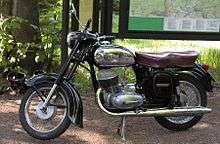Česká zbrojovka Strakonice
Česká zbrojovka (ČZ a.s.) is a Czech company producing components for the automobile industry and former firearms manufacturer also known for making ČZ motorcycles. ČZ was established as a branch of the Škoda Works Armament in Strakonice, Czechoslovakia in September 1919.[1]
History
Work started on the construction of the first workshops of the arms factory originally called Jihočeská zbrojovka ("South Bohemian Armament Works"). The company merged with an arms manufacturing plant in Vejprty and with a factory in Prague in 1922.[1] This gave rise to the formation of a stock company whose name translates as "Czech Armament Works in Prague of the Manufacturing Plant in Strakonice".[1] It produced pistols, air guns, and automatic guns which all became successful products.
In 1929 the growth of the Czech Armament Works reached a turning point. With the downturn in weapons sales after World War I, the company acquired a bicycle parts manufacturing plant in Kralupy nad Vltavou on the Vltava River.[1] Bicycle exports destined for several countries in Europe, Asia, Africa and South America started to expand.[1] Production of motor-driven bicycles started in 1932.[1] Three years later the first motorcycles made in Strakonice entered the market.[1] This marked the beginning of an era of great success for the ČZ brand. In a short time the company became the biggest manufacturer of motorcycles in Czechoslovakia.[1] Consequently, business success resulted in a further extension of production activities by introducing chain and machine tool production.[1] During the Second World War the factory came under German occupation and was converted to the manufacture of war materials.[1]
Like most large industrial enterprises this stock company was nationalized in 1946.[1] Due to the post-war political situation, arms production in the Strakonice plant was ended.[1] In 1948 ČZ Motorcycles merged with its main rival, Jawa.[1]


Motorcycle Development
Motorcycle development and production as well as competition victories in 1950s and 1960s enabled the ČZ brand to be among the world’s most successful makers of competition and street motorcycles. After World War II, ČZ was the second largest motorcycle manufacturer in Europe. It was during this period that the company experienced its greatest racing successes. It began competing in the 250 cc and 350 cc classes of Grand Prix motorcycle road racing. These bikes, although technically refined, were rarely very competitive with bikes from the powerful Italian factories such as MV Agusta, Gilera and Mondial.
In the 1969 ČZ produced the technically advanced "Type-860" GP model with a 350 cc V4 engine, developed by the engineer Frantisek Pudil. This advanced bike, with double overhead camshaft, 16 valves, 8-speed gearbox, Ceriani forks and Dell'Orto SSI carburetors, produced 63 horsepower (47 kW) at 16,000 rpm with a maximum speed of 240 km/h. The V-4 achieved several good results: the best being in 1971, at the Czechoslovakian Grand Prix when Bohumil Stasa finished second behind Jarno Saarinen on his 350 cc Yamaha. In 1972, the bike almost won the Austrian Grand Prix. With just few laps to go in the race the ČZ was leading Giacomo Agostini's MV Agusta when it had to retire with mechanical problems. In 1972 ČZ abandoned Grand Prix road racing competitions in order to concentrate its efforts on motocross, a less expensive form of competition.
ČZ proved to be much more successful with motocross and became well known for its powerful two-stroke off-road motorcycles.[2][3][4] They were the first company to use expansion chambers in their exhaust pipes. During the 1960s, they would become the dominant force in off-road competition, winning seven Grand Prix Motocross World Championships and dominating the International Six Day Trial.[2][3][4][5]
By the 1970s, with the advent of inexpensive and technically advanced Japanese motorcycles, ČZ lost an increasing share of the motorcycle market. Ironically, many of the innovations successfully pioneered by ČZ, were copied by the Japanese factories. In 1993 the motorcycle branch of ČZ was bought by the Italian motorcycle manufacturer Cagiva, who intended to use the Czech factories to build their own brand of motorcycles as well as new ČZ and Jawa models. The venture failed in 1997 due to Cagiva's financial difficulties and the ČZ motorcycle brand went out of production. The company changed and started focusing on manufacturing car components - gearboxes and turbofans, besides its traditional production of chains, tools, moulds, castings and machine tools.
Competition History
Motocross World Championships
- 1964 250 cc Motocross - Joël Robert, Belgium
- 1965 250 cc Motocross - Victor Arbekov, Russia
- 1966 500 cc Motocross - Paul Friedrichs, East Germany
- 1967 500 cc Motocross - Paul Friedrichs, East Germany
- 1968 500 cc Motocross - Paul Friedrichs, East Germany
- 1968 250 cc Motocross - Joël Robert, Belgium
- 1969 250 cc Motocross - Joël Robert, Belgium
International Six Day Trials Victories
- 1947 Trophy - Team Czechoslovakia
- 1952 Trophy - Team Czechoslovakia
- 1954 Trophy - Team Czechoslovakia
- 1956 Trophy - Team Czechoslovakia
- 1958 Trophy - Team Czechoslovakia
- 1959 Trophy - Team Czechoslovakia
- 1962 Trophy - Team Czechoslovakia
- 1970 Trophy - Team Czechoslovakia
- 1971 Trophy - Team Czechoslovakia
- 1972 Trophy - Team Czechoslovakia
- 1973 Trophy - Team Czechoslovakia
- 1974 Trophy - Team Czechoslovakia
- 1977 Trophy - Team Czechoslovakia
- 1978 Trophy - Team Czechoslovakia
- 1982 Trophy - Team Czechoslovakia
See also
References
- 1 2 3 4 5 6 7 8 9 10 11 12 13 "CZ Company History". czas.cz. 2003-01-01. Retrieved 2017-07-06.
- 1 2 "CZ Moto-cross Development". ahrmanwc/CZmx.htm. 2011-09-01. Retrieved 2017-07-06.
- 1 2 "1972 CZ 380 Motocross". ultimatemotorcycling.com. 2011-01-13. Retrieved 2017-07-06.
- 1 2 "CZ250 Twin Port -1965". earlyyearsofmx.com. 2006-01-01. Retrieved 2017-07-06.
- ↑ "International Six Days Trial History (1949 - 1980)". isdt.org. 2003-11-01. Retrieved 2017-07-06.
External links
- CZ History
- Article on the CZ 350 V4 Grand Prix race bike
- Jawa CZ Owners Club
- Jawa CZ Owners Club of Ireland
- CZ at Sechtl & Vosecek archive CZ-Strakonice in 1960s photo gallery
- International Six Days Trial